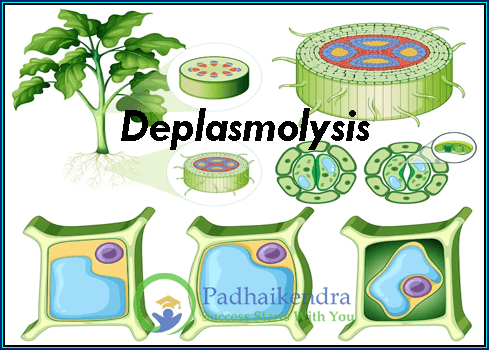Plasmolysis
Plasmolysis refers to the process in which cells lose water in a hypertonic environment – where there is more solute (like salt or sugar) outside the cell than inside the cell. This results in the cell becoming dehydrated. In plant cells, plasmolysis is particularly noticeable because the cell membrane (the thin layer that surrounds the cell) shrinks away from the cell wall (the rigid layer that provides structure to the plant cell).
Let’s think of a plant cell like a balloon filled with water, floating in a bowl of sugar syrup. If the syrup outside the balloon is thicker (that is, it has more sugar) than the water inside the balloon, the water inside will want to move out to the syrup to try to balance things out. That’s a principle in science we call ‘osmosis’. As the water leaves, the balloon will start to deflate, just like the cell membrane shrinks in plasmolysis.
Deplasmolysis
Deplasmolysis is the reverse process of plasmolysis. It occurs when plasmolysed cells are placed in a hypotonic solution – an environment where there is less solute outside the cell than inside the cell. This causes the water to flow back into the cell, rehydrating it and causing the cell membrane to move back toward the cell wall.
Going back to our balloon example, imagine now that we take our deflated balloon and put it in a bowl of plain water. Because the syrup inside the balloon is thicker than the water outside, the water will start to flow into the balloon to try to balance things out. The balloon will start to inflate again, just like the cell membrane expands in deplasmolysis.
In simple terms, plasmolysis is like the cell losing water and shrinking, while deplasmolysis is like the cell gaining water and expanding. Both processes are responses to the environment the cell is in, and they’re important for understanding how cells interact with their surroundings.
Difference between Plasmolysis and Deplasmolysis-
Plasmolysis
- Plasmolysis is the process in which the cell membrane contracts and detaches from the cell wall as a result of exosmosis.
- Molecules of water migrate out from the cell during this process.
- This occurrence is a result of exosmosis.
- Plasmolysis happens when cells find themselves in a hypertonic solution, where there is more solute outside the cell than inside.
- It takes place when the concentration of solutes in the surrounding solution surpasses that within the cell’s cytoplasm.
- This process can occur when the water potential (the tendency of water to move) of the surrounding solution is lower than that in the cell’s cytoplasm.
- As a result of this process, cells may undergo contraction or shrink.
- The osmotic pressure within the cell is significantly low during plasmolysis.
Deplasmolysis
- Deplasmolysis refers to the process where water reenters a dehydrated plant cell, prompting the cell membrane to reattach to the cell wall.
- During deplasmolysis, water molecules traverse into the cell.
- This event happens during endosmosis.
- Deplasmolysis is observed when cells are immersed in a hypotonic solution, where there is less solute outside the cell than inside.
- It occurs when the solute concentration of the solution surrounding the cell is lower than that in the cell’s cytoplasm.
- Deplasmolysis can occur when the water potential of the external solution exceeds that of the cell’s cytoplasm.
- As a result of this process, cells may expand or swell.
- The osmotic pressure against the cell wall significantly increases during deplasmolysis.





